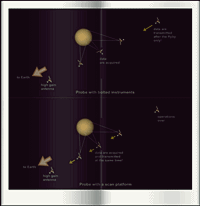
Planetary probes may be fit either with scan platforms or bolted sensing instruments. In the first case, the probe may beam data back while its instruments are acquiring data from the observed target as in the second, the craft has to perform orientation maneuvers in the purpose of getting the data. With the remote sensing instruments affixed unto a scan -moving- platform, the craft general attitude is staying steady, hence its high-gain antenna may continue to be directed Earth to the Deep Space Network (DSN) antennas, as with fixed gears, the craft has first to position itself to correctly aim the instruments as, during then, its communication antennas may be away from Earth. And then only it may come back to point its beaming devices Earth. Between the time the data are acquired and the time they are beamed back, they are stored on one or more Solid State Recorder (SSR). After a while after transmission, the data set on the craft's recorder are possible erased to make room for further date into a extended mission, for example
 | click to an illustration of how a planetary probe acquires and transmits data, function of how it works |
NASA Cassini mission, orbiting presently in the Saturn system, is equipped with fixed instruments, for example. It's working 15 hours during which it takes pictures and conduct science measurements, as it has nine hours to return the information, beaming about 500 raw images a day. Cassini two SSRs have of combined capacity of 4 gigabits
For most spacecraft with Solid State Recorders, the practice is to keep the data stored for one or more days -as recorders usually don't get filled with one session of imaging and scientific work. In any case however, when data are beamed back separately, a delay of 8 or more hours occurs between the end of data acquisition and their transmission as, on the other hand, the first 9-hour downlink session may be not enough to have the data back Earth, necessitating one or more downlink sessions. As far as data transfer rate is concerned, current missions handle a few hundred megabits per second in the near Earth environment and a few hundred kilobits per second in the deep space one. 'Rate stepping' is the technique using a spacecraftís position when itís higher in the sky over a NASA Deep Space Network antenna, making that the data signal can be sent at a higher rate because itís traveling through less atmosphere. Bad weather, on a other hand, causes a signal to drop out. The X-band frequency is the current standard on most NASA spacecraft for data transmission
In terms of orientation and stabilization of a planetary craft, generally, they are performed through startracker cameras. Startracker cameras take pictures of the sky and use internal databases to recognize the stars which determine the position and orientation of the probe in space. That information is calibrated with another tool, called gyroscopes, that tell the spacecraft what it's pointing at and what its angular rotation is. With the gyroscope information plus the calibrated information from startrackers a craft realizes its current attitude. Such cameras are crucial on all spacecraft, but are particularly important for interplanetary probes, since they have to continuously point their solar arrays at the Sun and their antennas at the Earth. As far as the future of space communications are concerned, optical communications technology through laser is expected to provide data rates up to 100-times higher than todayís systems, which will be needed for future human and robotic space missions. More small ground station will be used too. Also miniaturized mercury-ion atomic clocks will feature the craft with a 10-times more accuracy than todayís systems as the Ka-band frequency will allow for data rates about 16 times higher than the X-band
Website Manager: G. Guichard, site 'Amateur Astronomy,' http://stars5.6te.net. Page Editor: G. Guichard. last edited: 11/7/2016. contact us at ggwebsites@outlook.com